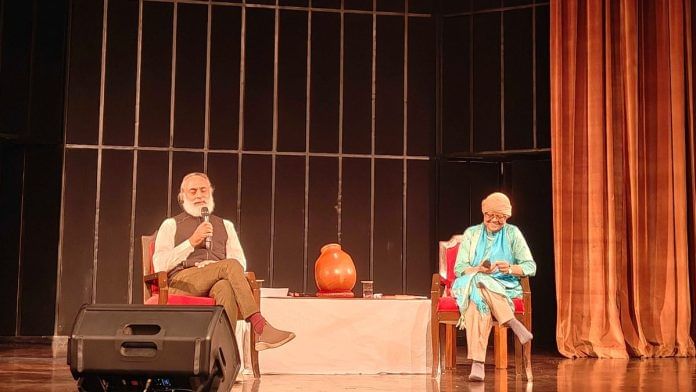New Delhi: Many years ago, when renowned Ghatam player Sumana Chandrashekar first expressed her interest in playing ghatam, a percussion instrument, she was told ‘gosh, your hands’.
“It was coming from the point of gender because the hands are going to get tough,” Chandrashekar said recently at the launch of her memoir ‘My Journey With The Ghatam: Songs of the Clay Pot’ at the Indian Habitat Centre in Delhi. Can a humble clay pot or ghatam have a rich musical journey? This and many other questions related to the people making the ghatam to the qualities it has, found their way into the conversation between Chandrashekar and dancer, scholar and yoga exponent Navtej Singh Johar.
But before the conversation began, the ghatam player enthralled a small audience gathered at the Stein auditorium. Chandrashekar explained each piece as she captivated her audience with her performance, by the end of which, they were clapping along. Chandrashekar reciprocated by pausing, giving space to the claps.
“I find the ghatam the most guileless of all musical instruments. It does not have the nakhra of tuning it. Tuning an instrument is attention-grabbing. It yields without preparation,” said Johar.
He also mentioned how the ghatam is considered a ‘low caste’ instrument, and for Chandrashekar to play, might appear rebellious. But he added that it was simply a case of choosing what ‘speaks’ to an artist.
Also read: Amish Tripathi has invested in India because European economies are failing
Root of the ghatam
The instrument has its own intricacies, like both hands being used in equal measure, and as Chandrashekar learnt to play, she began peeling off layers of knowledge about the instrument.
But one day, Chandrashekar got curious about the people who make the ghatam, and the instrument’s journey from a potter’s shed to the hall of music. And she decided to follow the claypot in its journey.
“I was at my practice when I started thinking, where does it come from? Who are the people making it?” Chadrashekhar said.
Singh then asked Chandrashekar about her relationship with the ghatam at the moment.
“She is sometimes my guru, sometimes she’s a friend, sometimes a parent. We are just two people having a conversation. She is living, breathing earth, and we both have our moods,” said Chandrashekar.
She added that her own observations about the people who make the ghatam, and their relationship with them. One potter would refer to the clay pots as ‘babies’.
“The baby can come out broken, may have a crack or have birthcracks. That relationship is precious because we are taught a certain distance of approaching it with a certain tentativeness. But they have a sense of intimacy,” said Chandrashekar of her time spent at Manamadurai, observing potters.
It is also this period that taught Chandrashekar of the ever-changing nature of the instrument, where a slight crack could alter the music that is created on the ghatam. But over time, she also learnt to embrace it as part of the instrument she plays.
According to her guru, ghatam ‘grows up’ in the company that embodies certain qualities of women, like resilience, strength and vulnerability.
“All of these are because the ghatam was nurtured by women,” said Chandrashekar.
The session would end just the way it started, with Chandrashekar playing TK Murthy’s composition. The rendition was composed for MS Subbulakshmi’s historic performance at the United Nations General Assembly on 23 October 1966.
(Edited by Saptak Datta)






